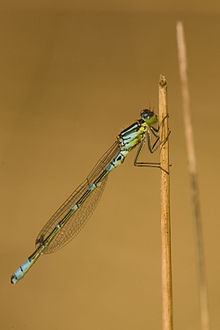- Irish Damselfly
-
Irish Damselfly or
Crescent Bluet
Scientific classification Kingdom: Animalia Phylum: Arthropoda Class: Insecta Order: Odonata Family: Coenagrionidae Genus: Coenagrion Species: C. lunulatum Binomial name Coenagrion lunulatum
(Charpentier, 1840)The Irish Damselfly or Crescent Bluet (Coenagrion lunulatum) is a damselfly found in northern Europe;[1] outside northern Finland the species is rare. It is also scarce and local in the Netherlands and Ireland.[1] One of its English name comes from the fact that it is found in Ireland but not in Britain. The alternative name, Crescent Bluet, refers to the shape of the markings on segment two of the male and its scientific name.
Contents
Appearance
This species is similar to the Azure Damselfly (Coenagrion puella), the Variable Damselfly (Coenagrion pulchellum) and the Common Blue Damselfly (Enallagma cyathigerum) with which it coexists. However, both the female and male are darker and shorter-bodied in comparison with other blue damselflies.
The species can be identified using the following features:
- In males the back of the abdomen is mostly black, whilst segments 8 and 9 are all blue.[1]
In males the underside is bright green especially on the head and thorax (see side view)
- The blue is of a darker shade than similar species
- Females are dull green with black markings
- In females the hind margin of the pronotum has a prominent raised point (see comparison of pronotums of blue damselflies)
Status in Ireland
In Ireland, the species is uncommon, and confined to the midlands and north.[2] It is listed as Vulnerable on the Red List of Irish dragonflies. [3]Adults have been recorded from the beinning of May (Adults seen in Co Tyrone on 1st May 2011) to late July. It is found on sheltered mesotrophic lakes and large pools, fens and cutover bogs.
It was first recorded in Ireland in Sligo in 1981; in total, it has been recorded from approximately 40 sites in 13 counties. The majority of sites have been in counties Fermanagh, Tyrone, Armagh and Monaghan. One of the places it has been successfully recorded and photographed is Brackagh Moss Bog, in Armagh.[4]
Eutrophication is suggested as the most serious threat to the species.
References
- ^ a b c "Coenagrion lunulatum - Irish Damselfly". British Dragonfly Society. http://british-dragonflies.org.uk/species/irish-damselfly. Retrieved 3 March 2010.
- ^ "Grid map of records on the Gateway for Irish Damselfly". National Biodiversity Network. http://data.nbn.org.uk/gridMap/gridMap.jsp?allDs=1&srchSpKey=24381&col=Red&date=Dragonflies&sy1=1975&ey1=2010&sy2=1950&ey2=1974&sy3=1600&ey3=1949&refreshMap=refresh+report#topOfMap. Retrieved 3 March 2010.
- ^ "Irish Red List No 6: Dragonflies and Damselflies". Nelson, B., Ronayne, C. and Thompson, R.. http://www.npws.ie/publications/redlists/RL6.pdf. Retrieved 6 May 2011.
- ^ "Brackagh Nature Reserve". Northern Ireland Environment Agency. http://www.ni-environment.gov.uk/places_to_visit_home/nature_resintro/nature_reserves_brackagh.htm. Retrieved 3 March 2010.
External links
Categories:- Coenagrionidae
- Damselflies of Europe
Wikimedia Foundation. 2010.
